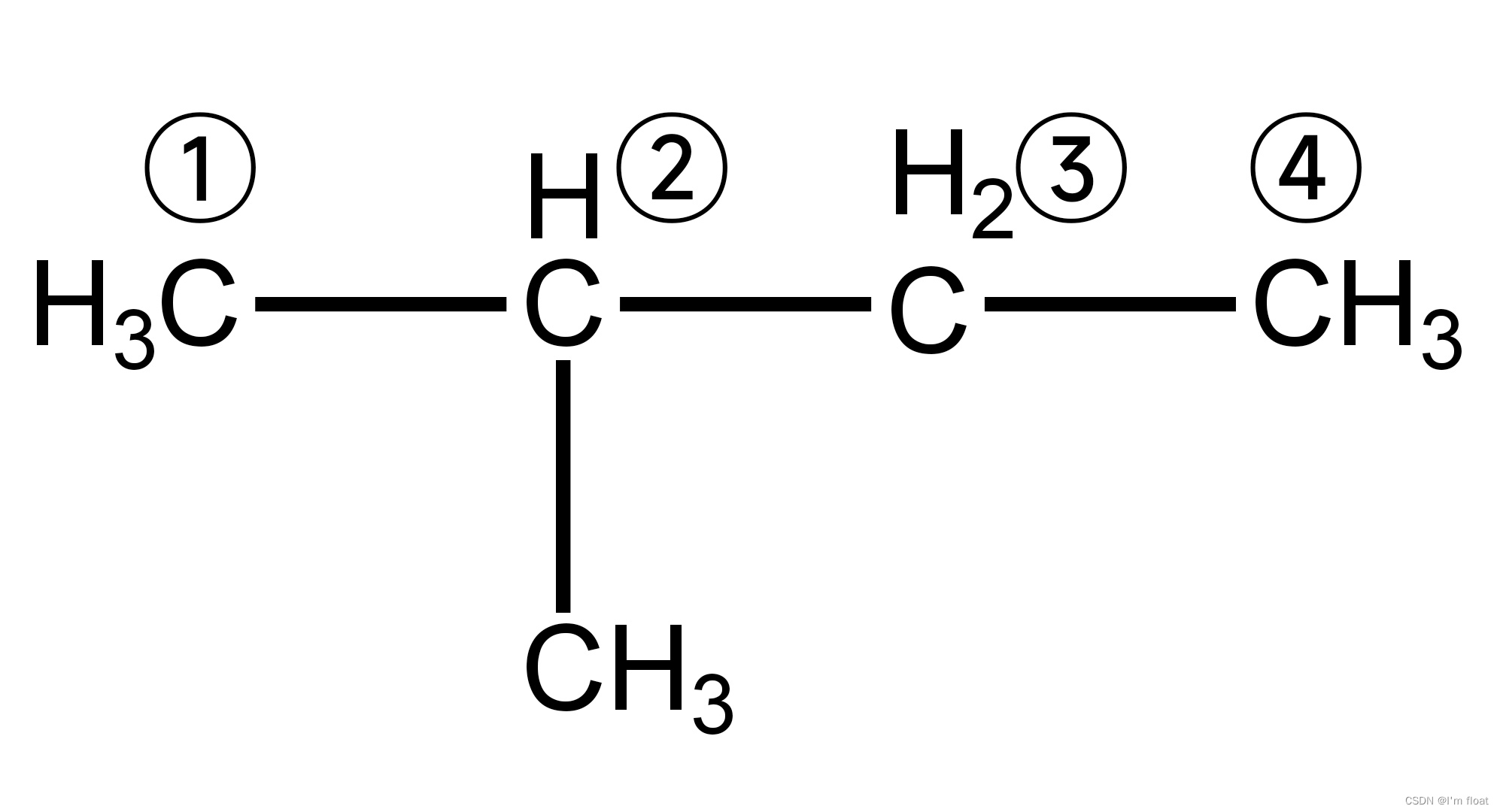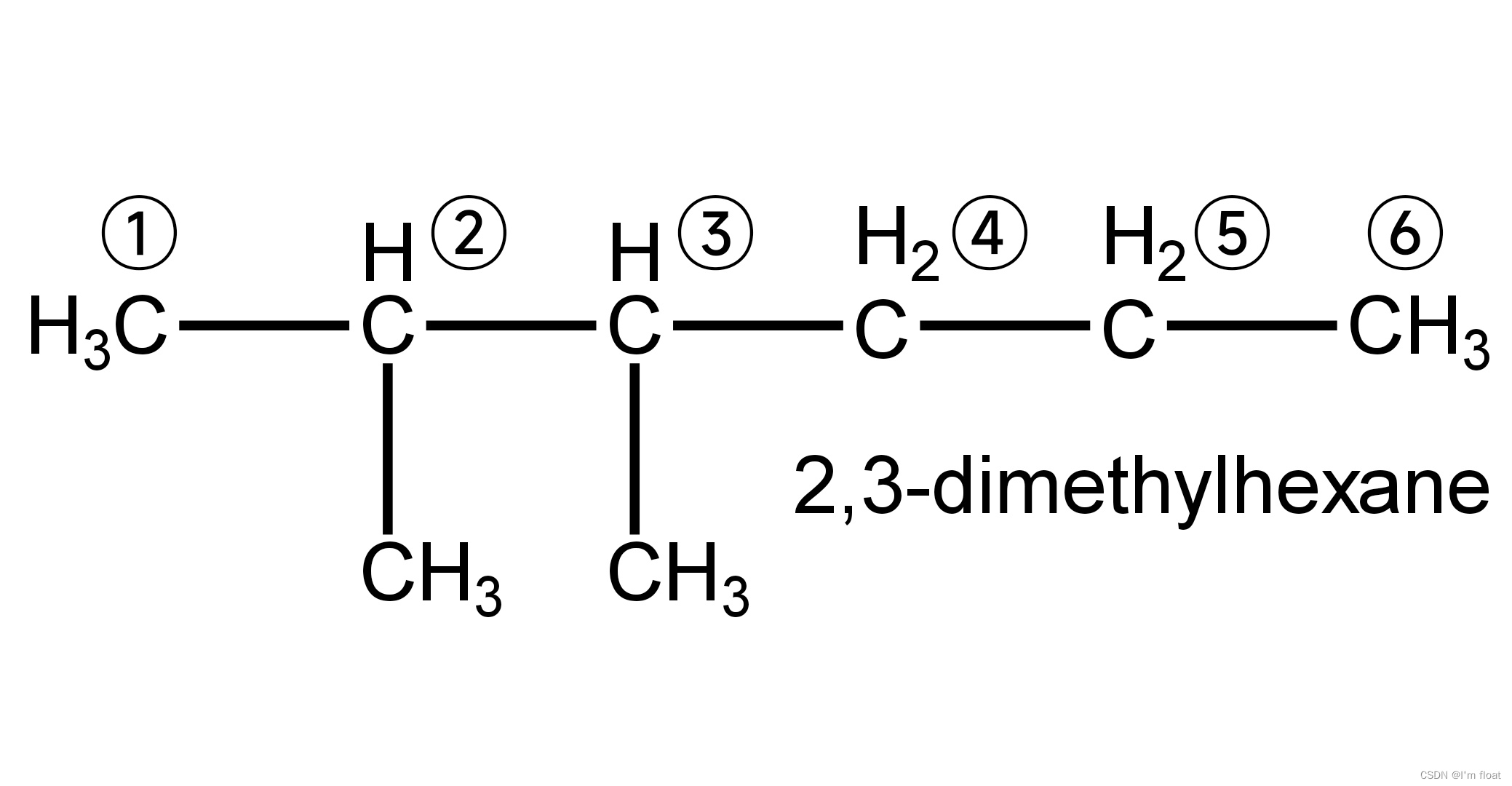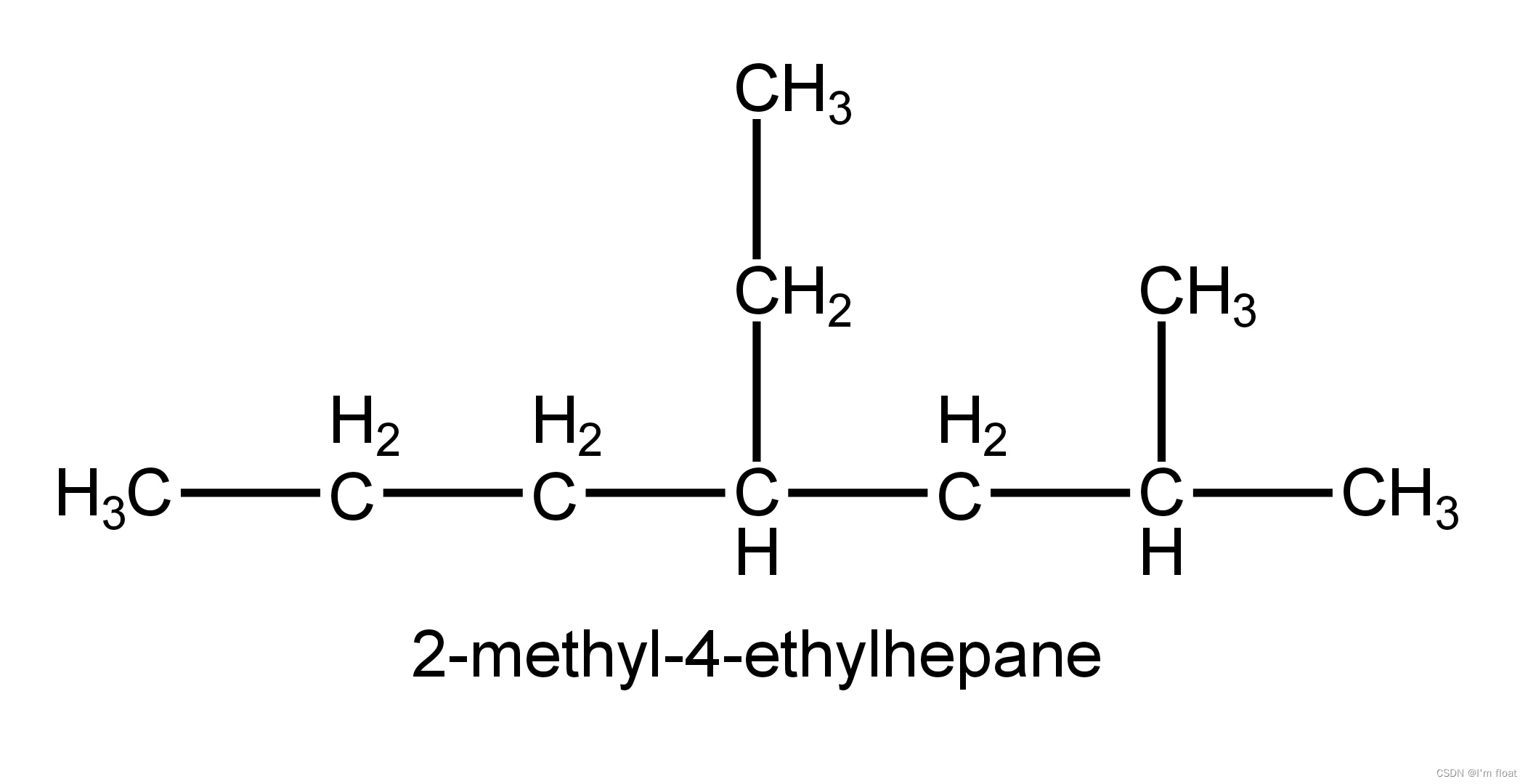简单有机物的英文命名法
发一篇化学的文章
索引
作者技术有限,若有不足敬请指教!
一. 简单烷烃的英文命名法
此章节为英文。如果您已了解此部分,请跳至第二部分。
Systematic Nomenclature of Alkanes
Step I The longest carbon chain in the molecule is chosen as the main chain, and it is called “N-ane” according to the number of carbon atoms in the main chain.
Step II Select the nearest section of the main chain from the branch chain as the starting point, and number each carbon atom in the main chain with Arabic number 1, 2, 3, …, for example:

Step III Write the names of branch chains before the name of the main chain, indicate its position on the main chain with a number in front of the branch chain, and separate the number from the name with a short line. For example, using systematic nomenclature for isopentane:

Step IV: If the main chain has the same branch chain, combine the branch chains. Use “di-”, “tri-” and so on to indicate the number of branch chains, and use commas (",") to separate the numbers indicating branch chain positions. Such as:
If there are different branch chains, the simpler appears earlier. For example:

二. 通用的烃(及其衍生物)英文命名法
2.1 烷烃及其取代物的英文命名
2.1.1 词头
有机物的英文命名中的“一”、“二”、“三”或“甲”、“乙”、“丙”等并不是用1、2、3或one、two、three来写的,而是有固定的词头。下面列出:
- 表示1~4的词头
(1) 主链母体词头
这类词头用于标识主链碳原子个数:
| 中文名 | 词头 |
|---|---|
| 甲 | metha- |
| 乙 | etha- |
| 丙 | propa- |
| 丁 | buta- |
需要注意的是:当这些以a结尾的词头后面接其它词时,如果后面接的词是以a开头的,那么这两个a只能保留一个。例如“甲”为“metha-”,“烷”为“-ane”,则最后写为“methane”。
(2) 侧链基团数目词头
这类词头用于标识某个侧链基团的数目:
| 中文名 | 词头 |
|---|---|
| 一 | mono- |
| 二 | di- (do-, bi-) |
| 三 | tri- |
| 四 | tetra- |
除非特殊说明,所有以a结尾的词头(包括后文所述的)都遵循上面讲到的相邻a字母只保留一个的规则。
- 表示5~10的词头
这些词头既可以表示主链碳原子个数,也可以表示侧链基团数目。
| 中文名 | 数字 | 词头 |
|---|---|---|
| 戊 | 五 | penta- |
| 己 | 六 | hexa- |
| 庚 | 七 | hepta- |
| 辛 | 八 | octa- |
| 壬 | 九 | ennea- (nona-) |
| 癸 | 十 | deca- |
- 表示11~19的词头
将“十”的词头“deca-”作为基数,“十几”就在其前面加对应数字词头。
| 变化规律 | 数字 | 词头 |
|---|---|---|
| 不规则变化 | 十一 | hendeca- (undeca-) |
| 规则变化 | 十二 | dodeca- |
| 十三 | trideca- | |
| 十四 | tetradeca- | |
| 十五 | pentadeca- | |
| 十六 | hexadeca- | |
| 十七 | heptadeca- | |
| 十八 | octadeca- | |
| 十九 | nonadeca- |
除11以外,其它全部都是“数字词头+deca-”的形式。注意:表示两位数时,个位上的2必须用do-,个位上的9必须用nona-。
- 表示20~29的词头
| 数字 | 词头 |
|---|---|
| 二十 | eicosa- |
| 二十一 | heneicosa- |
其余数字为“个位词头+cosa-”(注意不是加“eicosa-”)。
- 表示30~99的词头
(1) 整十数
十位用“tri-”等前缀表示,加“-aconta-”。
例如:
“三十”——“triaconta-”
“八十”——“octaconta-”
(2) 非整十数
在对应的整十数前面加个位数词头前缀。例如:
“六十”——“hexaconta-”
“六十五”——“pentahexaconta-”
2.1.2 直链烷烃的英文命名
烷的后缀词头为“-ane”。
命名方法:碳原子数目词头+“-ane”。
例如:“三十二烷”——“dotriacontane”
这里顺带把前十种烷烃的英文名列举出来:
| 中文名 | 英文名 |
|---|---|
| 甲烷 | methane |
| 乙烷 | ethane |
| 丙烷 | propane |
| 丁烷 | butane |
| 戊烷 | pentane |
| 己烷 | hexane |
| 庚烷 | heptane |
| 辛烷 | octane |
| 壬烷 | nonane |
| 癸烷 | decane |
2.1.3 带有支链的烷烃的英文命名
2.1.3.I 烷基的英文命名
烷基的英文命名法为:将烷基对应的数词词头末尾的“a”改为“yl”。例如:
“戊”——“penta-”
“戊基”——“pentyl”
戊基的俗名为amyl。
又如:
“1-甲基丁基”——“1-methylbutyl”
另外还有四种词头:
| 词头 | 英文名 |
|---|---|
| 仲 | sec- |
| 异 | iso- |
| 叔 | tert- |
| 新 | neo- |
例如:“异戊烷”——“isopentane”。
2.1.3.II 支链烷烃的英文命名
构词方法:支链位置(数字)-支链数目词头 支链名称 直链烷烃名称。例如:
“2,5,6-三甲基辛烷”——“2,5,6-trimethyloctane”
构词为:
“三”——tri
“甲基”——“methyl”
“辛烷”——“octane”
2.1.4 烷烃的一元取代物的英文命名
将取代基写在原烷烃名称的前面。例如:
“溴乙烷”——“bromoethane”
溴的英文名称为bromine,作前缀时常写作bromo或bromide,此处使用bromo。
2.1.5 环烷烃的英文命名
2.1.5.I 简单环烷的英文命名
直接在对应的直链烷烃前加前缀“cyclo-”。例如:
“丙烷”——“propane”
“环丙烷”——“cyclopropane”
2.1.5.II 含烷基的环烷的英文命名
在母体环烷的全称前加上烷基前缀。例如:
“己烷”——“hexane”
“环己烷”——“cyclohexane”
“甲基环己烷”——“methylcyclohexane”
2.1.5.III 含桥环的环烷的英文命名
词头写总环数(“二”用“bi-”),再接“-cyclo-”,接着方括号中数字从大到小写桥上的直链烷。例如:
“三环[3.2.1.0]辛烷”——“tricyclo[3.2.1.0]octane”
2.2 烯/炔烃的英文命名
2.2.1 只含一个双键的烯烃
将对应烷烃的词尾“-ane”改为“-ene”(或“-ylene”)。例如:
“丁烷”——“butane”
“丁烯”——“butene”
“2-丁烯”——“2-butane”
2.2.2 含多个双键的烯烃
在“-ene”前加双键数目词头。例如:
“1,2-丁二烯”——“1,2-butadiene”
“1-乙基-1,2-丁二烯”——“1-ethyl-1,2-butadiene”
“1-甲基螺[4,4]-2,7-壬二烯”
——“1-methylspiro[4,4]-2,7-nonadiene”
2.2.3 炔烃的英文命名
炔烃的英文命名方法与烯烃类似,只是把烷烃的“-ane”改为“-yne”。例如:
“5-甲基环-1-辛炔”——“5-methylcyclo-1-octyne”
注意:在炔烃的名称中如果有“烯”(-ene-)这个词头,应将“-ene-”改为“-en-”。
2.3 烃的取代物的英文命名(包括脂肪烃)
这里就把芳香烃和脂肪烃的取代物一并讲了,不作细分。
2.3.1 硝基、烷基、卤素等简单的一元取代物的英文命名
构词方法:母体用烃的全称,在母体前加上取代基词头。例如:
“1-溴-2-丁烯”——“1-bromo-2-butene”
下面列举几个常用的简单取代基名称:
| 基团名称 | 英文名 |
|---|---|
| 苯基 | phenyl |
| 甲基 | methyl |
| 乙基 | ethyl |
| 丙基 | propyl |
| 硝基 | nitryl |
| 氨基 | amino |
2.3.2 苯的二元取代物的英文命名
苯的二元取代物的取代基有三种位置关系:
| 位置 | 中文名 | 英文名 | 全称 |
|---|---|---|---|
| 1,2 | 邻 | o- | ortho |
| 1,3 | 间 | m- | meta |
| 1,4 | 对 | p- | para |
苯的取代物的命名中,苯的英文(benzene)前需补充“-yl-”词头。例如:
“对甲基丙苯”——“p-methylpropylbenzene”
苯的三元取代物与二元取代物类似,这里不再赘述,仅给出一例作为参考:
“1-甲基-3,5-二乙基苯”
——“1-methyl-3,5-doethylbenzene”
除此之外,这里给出6个基团的俗名以做参考:
| 中文名 | 英文全称 | 俗名 |
|---|---|---|
| 甲苯 | methylbenzene | toluene |
| 二甲苯 | domethylbenzene | xylene |
| 异丙苯 | isopropylbenzene | cumene |
| 1,3,5-三甲基苯 (均三甲苯) | 1,3,5-trimethylbenzene | mesitylene |
| 4-异丙基甲苯 (对异丙基甲苯) | 4-p-propylmethylbenzene | cyneme |
| 苯乙烯 | phenylethene | styrene |
2.3.3 多苯代脂烃的英文命名
命名方法:将苯基看作普通基团命名。例如:
“1,2-二苯基乙烷”——“1,2-diphenylethene”
2.3.4 联苯的命名
与多苯代脂烃的命名相似,但用苯基(phenyl)代替苯(benzene),并在前面注明苯的数目(“二”用“-bi-”)。
注意:但中文命名中有时将带单引号的位置写在前面,英文命名中将带单引号的位置写在后面。例如:
“4’-甲基-3-乙基联苯”——“3-ethyl-4’-methylbiphenyl”
THE END